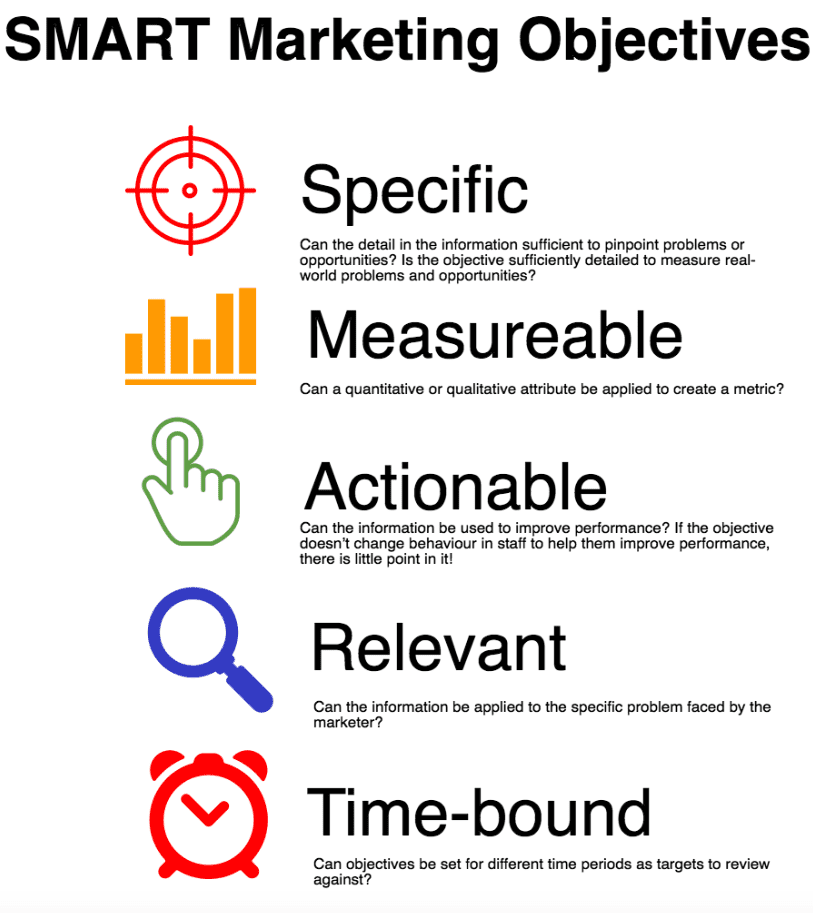From SMART to SMARTER marketing objectives
When identifying specific marketing objectives to support your long-term goals, it is common practice to apply the widely used SMART mnemonic. You will know that SMART is used to assess the suitability of objectives set to drive different strategies or the improvement of the full range of business processes.One of the main reasons that we called our site and service SMART Insights is because we wanted to help marketers succeed through using a more structured approach to planning to give more realistic targets they could be more confident of achieving. Using SMART objectives and then measuring them through properly customised analytics reports is a big part of how we hope to help too.
With SMART objectives documented in Plans linking objectives to strategies and KPIs everyone is sure exactly what the target is, progress towards it can be quickly and regularly reviewed, for example through an Ecommerce dashboard and, if necessary, action can be taken to put the plan back on target.
How can SMART objectives help set realistic targets?
When setting future objectives for marketing such as in a marketing plan it’s useful to look hard at each measure and ask “is it essential?”. The SMART mnemonic helps as a test or filter which you can use to assess the quality of measures. My personal definition of SMART is:- Specific – Can the detail in the information sufficient to pinpoint problems or opportunities? Is the objective sufficiently detailed to measure real-world problems and opportunities?
- Measurable – Can a quantitative or qualitative attribute be applied to create a metric?
- Actionable – Can the information be used to improve performance? If the objective doesn’t change behaviour in staff to help them improve performance, there is little point in it!
- Relevant – Can the information be applied to the specific problem faced by the marketer?
- Time-bound – Can objectives be set for different time periods as targets to review against?

Examples of SMART objectives
Here are some typical examples of SMART objectives, including those to support objective setting in customer acquisition, conversion and retention categories for digital marketing:- Digital channel contribution objective. Achieve 10% online revenue contribution within two years.
- Acquisition objective. Acquire 50,000 new online customers this financial year at an average cost per acquisition (CPA) of £30 with an average profitability of £5.
- Conversion objective. Increase the average order value of online sales to £42 per customer.
- Engagement objective. Increase active customers purchasing at least once a quarter to 300,000 in a market (a hurdle rate metric)
Mistakes in setting objectives
It’s worth guarding against the mistake I sometimes see with student assignments where, rather than listing objective examples like those above, the student will create separate objectives under a heading of each of SMART - this doesn’t work… Better is to group objectives in a logical way, sometimes separating out overall business and marketing objectives and digital marketing objectives.Another mistake to avoid is a big long list of objectives - yes I have seen a whole page of bullets with no structure... Instead group them logically in a way you would present them to colleagues. We recommend structuring them based on the RACE framework as show in this table aligning objectives to strategies and KPIs
The Ten Measures Design Tests
You can add to your tests of choosing the right objectives using these 10 measure design tests developed by performance management specialist Professor Andy Neely. For SMARTER metrics, ask these questions for your KPIs as you develop them.- 1. The truth test. Are we really measuring what we set out to measure?
- 2. The focus test. Are we only measuring what we set out to measure?
- 3. The relevancy test. Is it the right measure of the performance measure we want to track?
- 4. The consistency test. Will the data always be collected in the same way whoever measures it?
- 5. The access test. Is it easy to locate and capture the data needed to make the measurement?
- 6. The clarity test. Is any ambiguity possible in interpreting the results?
- 7. The so-what test. Can and will the data be acted upon, i.e. is it actionable?
- 8. The timeliness test. Can the data be accessed rapidly and frequently enough for action?
- 9. The cost test. Is the measure worth the cost of measurement?
- 10. The gaming test. Is the measure likely to encourage undesirable or inappropriate behaviours?
Alternative SMART objectives definitions
Finally, some have developed the SMARTER objectives definition that show the need to re-examine the relevance of SMART objectives through time:| Letter | Most Common | Alternative |
|---|---|---|
| S | Specific | Significant, Stretching, Simple, Sustainable |
| M | Measurable | Motivational, Manageable, Meaningful |
| A | Attainable | Appropriate, Achievable, Agreed, Assignable, Actionable, Adjustable, Ambitious. |
| R | Relevant | Results Based, Results-Oriented, Resourced, Realistic, Reasonable. |
| T | Time-Bound | Timed, Time-Framed, Time-Specific, Timetabled, Time limited, Trackable, Tangible. |
| E | Evaluate | Ethical, Enjoyable, Engaging, Evidenced |
| R | Reevaluate | Reviewed, Rewarded, Revisit, Recordable, Rewarding, Reaching. |







































